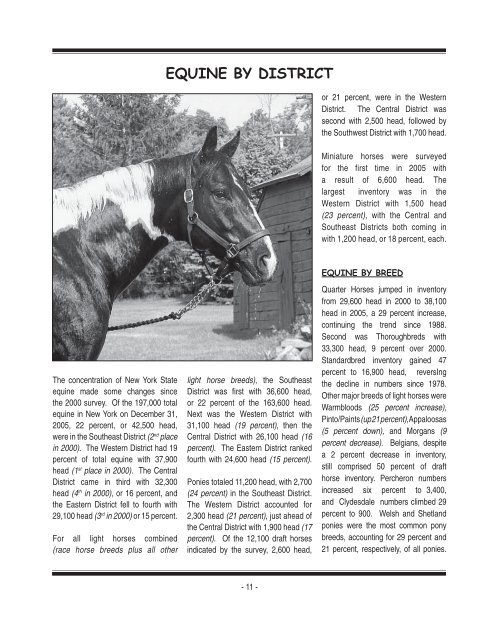Retired Racehorses
tfrr_reportandappendicesfinal
tfrr_reportandappendicesfinal
- No tags were found...
Create successful ePaper yourself
Turn your PDF publications into a flip-book with our unique Google optimized e-Paper software.
EQUINE BY DISTRICT<br />
or 21 percent, were in the Western<br />
District. The Central District was<br />
second with 2,500 head, followed by<br />
the Southwest District with 1,700 head.<br />
Miniature horses were surveyed<br />
for the first time in 2005 with<br />
a result of 6,600 head. The<br />
largest inventory was in the<br />
Western District with 1,500 head<br />
(23 percent), with the Central and<br />
Southeast Districts both coming in<br />
with 1,200 head, or 18 percent, each.<br />
EQUINE BY BREED<br />
The concentration of New York State<br />
equine made some changes since<br />
the 2000 survey. Of the 197,000 total<br />
equine in New York on December 31,<br />
2005, 22 percent, or 42,500 head,<br />
were in the Southeast District (2 nd place<br />
in 2000). The Western District had 19<br />
percent of total equine with 37,900<br />
head (1 st place in 2000). The Central<br />
District came in third with 32,300<br />
head (4 th in 2000), or 16 percent, and<br />
the Eastern District fell to fourth with<br />
29,100 head (3 rd in 2000) or 15 percent.<br />
For all light horses combined<br />
(race horse breeds plus all other<br />
light horse breeds), the Southeast<br />
District was first with 36,600 head,<br />
or 22 percent of the 163,600 head.<br />
Next was the Western District with<br />
31,100 head (19 percent), then the<br />
Central District with 26,100 head (16<br />
percent). The Eastern District ranked<br />
fourth with 24,600 head (15 percent).<br />
Ponies totaled 11,200 head, with 2,700<br />
(24 percent) in the Southeast District.<br />
The Western District accounted for<br />
2,300 head (21 percent), just ahead of<br />
the Central District with 1,900 head (17<br />
percent). Of the 12,100 draft horses<br />
indicated by the survey, 2,600 head,<br />
Quarter Horses jumped in inventory<br />
from 29,600 head in 2000 to 38,100<br />
head in 2005, a 29 percent increase,<br />
continuing the trend since 1988.<br />
Second was Thoroughbreds with<br />
33,300 head, 9 percent over 2000.<br />
Standardbred inventory gained 47<br />
percent to 16,900 head, reversIng<br />
the decline in numbers since 1978.<br />
Other major breeds of light horses were<br />
Warmbloods (25 percent increase),<br />
Pinto/Paints (up 21 percent), Appaloosas<br />
(5 percent down), and Morgans (9<br />
percent decrease). Belgians, despite<br />
a 2 percent decrease in inventory,<br />
still comprised 50 percent of draft<br />
horse inventory. Percheron numbers<br />
increased six percent to 3,400,<br />
and Clydesdale numbers climbed 29<br />
percent to 900. Welsh and Shetland<br />
ponies were the most common pony<br />
breeds, accounting for 29 percent and<br />
21 percent, respectively, of all ponies.<br />
- 11 -


